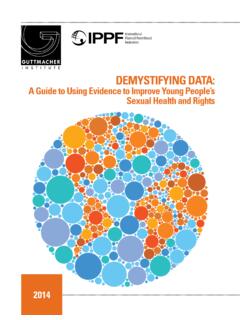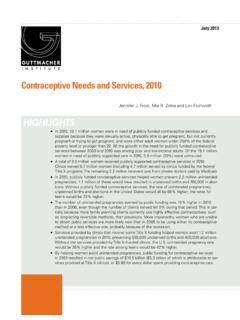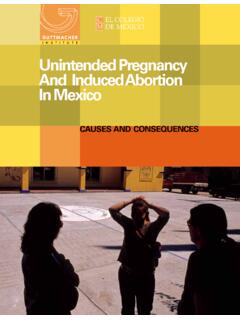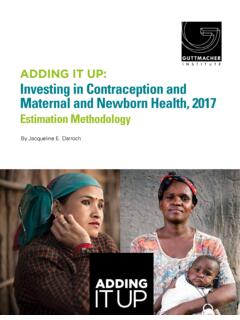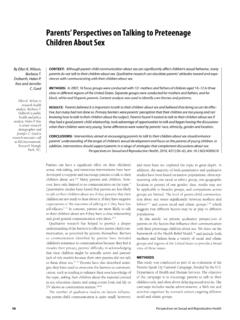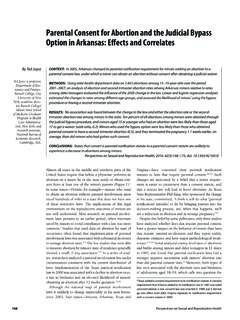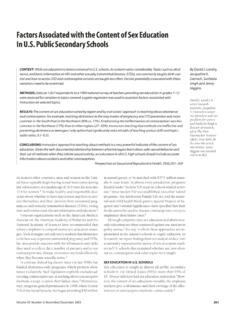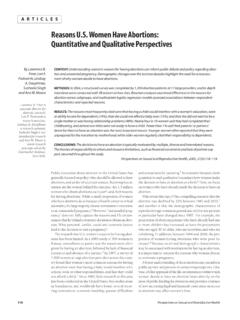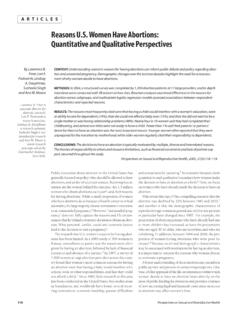Transcription of A Definition of Comprehensive Sexuality Education
1 1 Informational handouts on Comprehensive Sexuality Education , youth-friendly services, gender issues and sexual rightsDemystifying Data Toolkit Comprehensive Sexuality Education guttmacher InstituteA Definition of Comprehensive Sexuality EducationA rights -based approach to Comprehensive Sexuality Education (CSE) seeks to equip young people with the knowledge, skills, attitudes and values they need to determine and enjoy their Sexuality physically and emotionally, individually and in relationships. It views Sexuality holistically, as a part of young people s emotional and social development. It recognizes that information alone is not enough. Young people need to be given the opportunity to acquire essential life skills and develop positive attitudes and covers a broad range of issues relating to the physical, biological, emotional and social aspects of Sexuality .
2 This approach recognizes and accepts all people as sexual beings and is concerned with more than just the prevention of disease or pregnancy. CSE programs should be adapted to the age and stage of development of the target must help young people to:n Acquire accurate information on sexual and reproductive rights , information to dispel myths, and references to resources and Develop life skills including critical thinking, communication and negotiation, self-development and decision-making; sense of self; confidence; assertiveness; ability to take responsibility; ability to ask questions and seek help; and Nurture positive attitudes and values, including open-mindedness, respect for self and others, positive self-worth/esteem, comfort, nonjudgmental attitude, sense of responsibility, and positive attitude toward their sexual and reproductive handouts on Comprehensive Sexuality Education , youth-friendly services, gender issues and sexual rightsSeven Essential Components of Comprehensive Sexuality EducationI Gender: Difference between gender and sex; exploring gender roles and attributes; understanding perceptions of masculinity and femininity within the family and across the life cycle; society s changing norms and values; manifestations and consequences of gender bias, stereotypes and inequality (including self-stigmatization).
3 2 Sexual and reproductive health and HIV: Sexuality and the life cycle ( , puberty, menopause, stigma, sexual problems); anatomy; reproductive process; how to use condoms and other forms of contraception (including emergency contraception); pregnancy options and information; legal and safe abortion; unsafe abortion; understanding HIV and other sexually transmitted infections (STIs), including transmission and symptoms; HIV and STI prevention, treatment, care and support; voluntary counseling and testing for HIV; antiretroviral therapy and living with HIV; prevention of mother-to-child transmission; injection drug use and HIV; virginity; abstinence and faithfulness; sexual response; social expectations; self-esteem and empowerment; respect for the body; myths and Sexual rights and sexual citizenship: Knowledge of international human rights and national policies, laws and structures that relate to people s Sexuality ; rights -based approach to sexual and reproductive health; social, cultural and ethical barriers to exercising rights related to sexual and reproductive health; understanding that Sexuality and culture are diverse and dynamic; available services and resources and how to access them; participation; practices and norms; diversity of sexual identities; advocacy; choice; protection; negotiation skills; consent and the right to have sex only when you are ready.
4 The right to freely express and explore one s Sexuality in a safe, healthy and pleasurable Pleasure: Having a positive approach to young people s Sexuality ; understanding that sex should be enjoyable and consensual; understanding that sex is much more than just sexual intercourse; Sexuality as a healthy and normal part of everybody s life; the biology and emotions behind the human sexual response; gender and pleasure; sexual well-being; safer sex practices and pleasure; masturbation; love, lust and relationships; interpersonal communication; the diversity of Sexuality ; the first sexual experience; consent; alcohol, drugs and the implications of their use; addressing stigma associated with Data Toolkit Comprehensive Sexuality Education guttmacher Institute3 Informational handouts on Comprehensive Sexuality Education , youth-friendly services, gender issues and sexual rights5 Violence: Exploring the various types of violence toward men and women and how they manifest, particularly gender-based violence; nonconsensual sex and understanding what is unacceptable; rights and laws; support options available and seeking help; community norms and myths regarding power and gender; prevention, including personal safety plans; self-defense techniques; understanding the dynamics of victims and abusers; appropriate referral mechanisms for survivors; preventing the victim from becoming a perpetrator.
5 Men and boys as both perpetrators and allies in violence Diversity: Recognizing and understanding the range of diversity in our lives ( , faith, culture, ethnicity, socioeconomic status, ability/disability, HIV status and sexual orientation); a positive view of diversity; recognizing discrimination, its damaging effects and being able to manage it; developing a belief in equality; supporting young people to move beyond just Relationships: Different types of relationships (family, friends, sexual, romantic etc.); that relationships are constantly changing; emotions; intimacy (emotional and physical); rights and responsibilities; power dynamics; recognizing healthy and unhealthy or coercive relationships; communication, trust and honesty in relationships; peer pressure and social norms.
6 That love and sex are not the : Data Toolkit Comprehensive Sexuality Education guttmacher Institute4 Informational handouts on Comprehensive Sexuality Education , youth-friendly services, gender issues and sexual rightsDemystifying Data Toolkit Youth-Friendly Services guttmacher InstituteYouth-Friendly ServicesYouth-friendly service delivery is about providing health services based on a Comprehensive understanding of what young people in any given society or community want and need. It is also based on an understanding of, and respect for, the realities of young people s diversity and sexual youth-friendly approach requires offering young people a wide range of sexual and reproductive health services, includingn Sexual and reproductive health counselingn Contraceptive counseling and provision (including emergency contraception)
7 N Abortion servicesn Prevention, testing and counseling services for HIV and other STIsn Prenatal and postpartum servicesn Sexual abuse counseling n Relationship and Sexuality counselingYouth-friendly service delivery should also take into account the special needs of young peoplen Where possible, these services should be provided in an integrated manner at the same delivery point to allow for ease of access for young The financial barriers that young people can face should also be recognized and services should be provided free of charge or at a discounted rate to young clients. n Services are only truly youth-friendly if young people themselves are involved in determining the content, scope, and monitoring and evaluation of such services. Source: handouts on Comprehensive Sexuality Education , youth-friendly services, gender issues and sexual rightsEffective Youth-Friendly ServicesWhether services are provided in a clinical setting, a youth-oriented site, in schools or in the community, certain youth-friendly characteristics are essential for effective services.
8 N Providers should be trained to work competently, sensitively and respectfully with adolescents and young people on their sexual and reproductive health Services must be confidential, nonjudgmental and Clinic opening hours should be convenient for adolescents and young people: Such times include late afternoons (after school), evenings and Services should be accessible to all adolescents and young people, irrespective of their age, marital status, sexual orientation or ability to Effective referral systems should be in Opportunities should be made available for adolescents and young people to be involved in designing, implementing and evaluating the program. n Services should seek to involve and gain the support of those important in the lives of young people and in the local community, such as partners, parents/guardians and : Data Toolkit Youth-Friendly Services guttmacher Institute6 Informational handouts on Comprehensive Sexuality Education , youth-friendly services, gender issues and sexual rightsDemystifying Data Toolkit Gender Issues guttmacher InstituteGender IssuesGender equality is at the very heart of human rights and United Nations values.
9 Equal rights for men and women is a fundamental principle of the United Nations Charter, adopted by world leaders in inequalities and discrimination deny individuals their sexual rights , routinely resulting in lasting damage to health and emotional well-being. Gender-based power inequalities are prevalent in many settings and prevent many individuals from making their own decisions about if, when and with whom to have sex; whether to use contraceptives; if and when to have children and how many to have; and how and whether to seek health and cultural norms often deny girls and women and often boys and men access to Comprehensive information about sexual and reproductive health. Such norms can perpetuate harmful traditions that cause physical and emotional damage.
10 Cultural expectations and dictates can deny girls and women the right to make choices about their own bodies and futures and prevent their ability to access health care. Gender-based violence encompasses all physical, sexual and psychological violence that is rooted in individuals gender roles or identities. Violence against women is the most common form of gender-based violence and one of the most pervasive violations of human rights worldwide. Gender-based violence can also be perpetrated against boys and men, often when their sexual or gender identity does not conform to heterosexual norms. Similarly, transgender people and men who have sex with men frequently experience and women are a very diverse population, but they represent one of the most vulnerable groups in the field of sexual and reproductive health and handouts on Comprehensive Sexuality Education , youth-friendly services, gender issues and sexual rightsTransgender people face complex barriers and discrimination.
